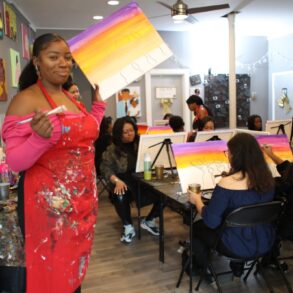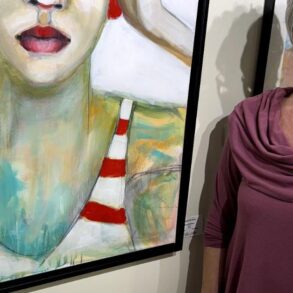Art
Tara Anne Dalbow
May 14, 2024 4:20PM
Portrait of Betye Saar, with Drifting Towards Twilight (2023), at the Huntingdon, 2023. Photo by Joshua White. Courtesy of the artist and Roberts Projects Los Angeles.
Betye Saar has made art for over six decades, yet in many ways, her work feels more relevant and urgent than ever. Her intricate and inventive collages, assemblages, and installations, dating back to the 1960s, merge the political with the mystical, imbuing historical narrative with personal, ancestral memory. Comprised of salvaged objects as various as washboards, handkerchiefs, African masks, jewelry boxes, and window panes, her constructions interrogate racism, sexism, cultural identity, and national mythology.
In one influential assemblage work, The Liberation of Aunt Jemima (1972)—which activist Angela Davis credited with sparking the Black women’s movement—Saar armed a smiling mammy figurine with a rifle and a hand grenade, a comment on both the physical violence inflicted on Black Americans and the danger of derogatory stereotypes. “That work not only captures the essence of the era but also reflects the current climate of social activism and protest,” explained Julie Roberts, co-owner of Roberts Projects and Betye Saar Catalogue Raisonné Project. “Betye’s assemblages demonstrate how much the past informs our present by making connections across time, recycling objects, and recontextualizing their histories.”
Betye Saar, installation view of Drifting Towards Twilight (2023) at the Huntingdon, 2023. Photo by Joshua White. Courtesy of the artist and Roberts Projects, Los Angeles.
Advertisement
Her large-scale site-specific installation Drifting Toward Twilight (2023), on view now at the Huntington in San Marino, California, envisages this liminal space where past and present meet. A 17-foot-long canoe built during World War II, and loaded with antlers, birdcages, and miniature chairs, rests on a bed of newly culled branches from the Huntington’s Botanical Gardens.
This installation is but one of many recent celebrations of her astonishing career. In just the last year, the 97-year-old Saar has been the subject of numerous solo exhibitions, including Roberts Projects’s “Betye Saar: New Work”; the Isabella Stewart Gardner Museum’s “Betye Saar: Heart of a Wanderer”; and the Luzern Kunstmuseum’s “Betye Saar: Serious Moonlight,” in Switzerland. “Betye’s assemblages demonstrate how much the past informs our present by making connections across time, recycling objects, and recontextualizing their histories,” said Roberts.
Alison Saar, The Beckoning, 2021. Courtesy of L.A. Louver.
The scope and scale of her influence are evident also in the profusion of artists following in her stead, particularly in her hometown of Los Angeles. A glance at the last two editions of Frieze Los Angeles, for example, reveals the extent of her legacy, where Black women artists like Alison Saar (Betye’s daughter), vanessa german, Bisa Butler, Rachel Eulena Williams, and Dominique Moody all subvert conventional material hierarchies and reclaim history in their work.
Alison learned the latent potential in cast-off materials directly from her mother, who brought her and her two sisters along on flea market and garage sale runs. Both her printmaking and sculpture practices evoke the memory contained within objects. “This idea was carried across the Atlantic by our ancestors, that objects—through touch and libations—accumulate power and spirit,” said Alison.
Portrait of Alison Saar by Jeff McLane, 2016. Courtesy of the artist and L.A. Louver.
“I believe that Betye’s work most notably showed that negative images and objects can be transformed into powerful icons that can guide us toward liberation,” Alison explained. In her 2023 exhibition “Uproot” at L.A. Louver, Alison recast the anonymous, sterilized figure of the Sable Venus as a conch-carrying, cat-fishing-steering symbol of fertility, strength, and grace in Mutiny of the Sable Venus (2022). Elsewhere in the exhibition, the gleaming female statue in DeConkified (2022) is shown having cut off her long, chemically straightened hair, embracing her African American identity and rejecting the beauty standards that idealize smooth, flowing locks.
Self-taught “citizen artist” vanessa german also erects emancipated, empowered figures from found objects. Modeled after Congolese Nkisi sculptures, she incorporates ritualistic totems and folk art in her assemblages along with “American Dream” paraphernalia, junk drawer bric-a-brac, and various organic materials like quartz and seashells. In her mixed-media construction Aunt Jemima and All Points In Space and Time are Connected (2020), german pays homage to Betye Saar’s Aunt Jemima assemblage by enshrining the mammy character and her miniature revolver in an appliquéd wooden drawer.
Self-portrait of vanessa german. Courtesy of the artist.
“Betye has this way of situating herself and her objects in direct communication with the divine…aligned with deep magic Black power,” german explained, describing the overwhelming impact of the artist’s work. “She’s a scientist and a witch doctor, and her work is in some ways responsible for the air we’re breathing.” Channeling a similar relationship to the otherworldly, german’s presentation at this past edition of Frieze Los Angeles with Kasmin included a dozen intricately encrusted rose quartz busts, each accompanied by an audio recording of the artist incanting a prayer. The rosy profile of a woman in HEART OVERHEAD (2024), with an anatomical heart balanced atop her head like a crown, is typical of the artist’s tender approach.
Betye Saar’s approach has also influenced Black women artists beyond the medium of assemblage. For instance, textile artist Bisa Butler credits Betye Saar with creating a lineage that other artists have followed. “Whether or not people realize it, they’re falling in line behind Saar, even if they don’t know her work: She cut the path,” explained Butler, whose large-scale chromatic quilts celebrate African American joy and resilience.
Like Saar, Butler collages personal effects, cultural artifacts, and traditional craft elements to tell emotionally resonant and critically restorative narratives. Constructed from innumerable layers of fabric and intricate appliqué, Butler incorporates a miscellany of textiles and embellishments, including scraps from her grandmother’s sewing kit, Kente cloth from her father’s birthplace in Ghana, and, recently, glittery polyvinyl from the 1980s.
For Butler, Saar’s early radical assemblages created a precedent for making art that boldly addressed the sociopolitical implications of being a Black woman in America. “People, including my dad, told me not to reference politics in my art,” explained Butler. “But seeing Betye imbuing her views into her work made me unafraid to do the same.” After her first encounter with Saar’s The Liberation of Aunt Jemima, Butler composed 10 quilted iterations of the reimagined rifle-carrying mammy figure.
Portrait of Bisa Butler by Robin Twomey. Courtesy of the artist.
Like Butler, mixed-media artist Rachel Eulena Williams found a model for using unconventional materials to portray a subjective feminine interiority in Saar. “It was a long time before I saw another artist who looked like me [who was] using found objects,” explained Williams. “There was this very soft, very delicate, and loving energy to them…finally, a female perspective.” Constructed from recycled fabrics, scavenged hardware, wooden frames, and paint-soaked ropes, Williams’s vibrant wall-mounted assemblages conjure tenderness and aggression, vulnerability and defensiveness, grace and gravity.
For her current exhibition at Canada Gallery, “Dream Speak,” on view through June 1st, the artist imagines her sculptures as manifestations of handwritten diary entries. Recalling the intimacy Williams recognized in Saar’s assemblages, she employs tubular pillow components, swatches of printed textiles, and flower-shaped armatures. Beneath the force of arduous emotions, sociopolitical commentary, and the rigid surface of wood and paint are silkscreen prints of cosmic iconography, luminous washes of aqueous color, and soft swirling marks that appear to inscribe a spell.
Portrait of Rachel Eulena Williams in her studio. Courtesy of the artist.
Rachel Eulena Williams, Snow Swell, 2024. Courtesy of the artist and Canada Gallery.
Dominique Moody, whose practice also combines assemblage with architecture, first met Saar at the iconic Watts Towers Art Center in Los Angeles. Consisting of 17 sculptures constructed from steel and mortar embellished with glass, mosaic tiles, rocks, and shells, the towering installation attracted a community of artists interested in atypical materials and unorthodox modes of making. “Betye and the others at Watts Tower taught me that it’s about work, everyday work, and everyday items, and that’s it—we don’t need to elevate it; it already is,” Moody said.
Exhilarated by Saar’s ability to render the ordinary extraordinary and the large scale of her installations, Moody spent 12 years planning and building her most well-known work, N.O.M.A.D. (2015), a 150-square-foot mobile live-work structure crafted entirely from reclaimed materials like washing machine doors and barnwood floors. Her sculpture Sweat Equity (2004), featured in Francois Ghebaly’s presentation at Frieze Los Angeles, is also on wheels, a nod to her peripatetic lifestyle. Modeled from corrugated metal siding, glass bottles, newspaper print, and archival photographs, the mobile house simultaneously critiques current discriminatory housing policies and celebrates the resilience of the artist’s ancestors.
Dominique Moody, Sweat Equity, 2005. Courtesy of the artist.
Influenced by Betye Saar, these Black women artists investigate identity and its expression through objects, asking: What is a self but an assemblage of memories, influences, days past, and future dreams? As vanessa german put it: “People, all of us, are assemblages.”
Tara Anne Dalbow




